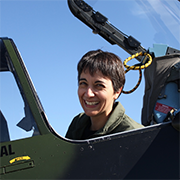A .gov website belongs to an official government organization in the United States.
A lock () or https:// means you've safely connected to the .gov website. Share sensitive information only on official, secure websites.

Measurements of trace gases from aircraft facilitate 3-dimensional studies of atmospheric composition and chemical processes and can provide a wealth of validation data for remotely-sensed observations. Carbon monoxide (CO) and nitrous oxide (N2O) are of particular interest as tracers of anthropogenic and surface influence. To measure these species unattended from NASA's WB-57 aircraft, our group is refining an off-the-shelf instrument which uses Off-Axis Integrated Cavity Output Spectroscopy (OA-ICOS). The COMA (Carbon mOnoxide Measurement from Ames) airborne instrument successfully collected data on all three recent test flights (approx. 20 hrs. in total), demonstrating significant resilience at reduced pressure and temperature. The flight series included vertical profiling between 45 and 59,000 ft, as well as level legs in the stratosphere and upper troposphere. We will report here on preliminary flight test results and preparations for deployment during the Asian Summer Monsoon Chemical & CLimate Impact Project (ACCLIP) field campaign.
A very different airborne measurement campaign based at Ames Research Center has been designed to provide long-term, regular observations of ozone, carbon dioxide, methane, and formaldehyde for comparison with satellite observations. We will report on the Alpha Jet Atmospheric eXperiment (AJAX) data set collected since 2011 and highlight plans for the future.
Dr. Laura Iraci leads the Trace Gas Group in the Earth Science Division at NASA Ames Research Center. She received her BA in Chemistry from Colgate University, and a PhD in Analytical and Atmospheric Chemistry from CU Boulder. She joined NCAR as a postdoctoral fellow, and then joined SRI International in Menlo Park, CA. In 2000, she joined NASA Ames as a research scientist. She is currently the PI of the Alpha Jet Atmospheric eXperiment (AJAX) Project, which conducts long-term routine aircraft-based monitoring of trace pollutants over the California coast. Dr. Iraci is also the deputy PI for the COMA instrument, which will be measuring carbon monoxide during the ACCLIP field campaign. She is the receipient of NASA’s Outstanding Leadership Medal in 2017.
ALL Seminar attendees agree not to cite, quote, copy, or distribute material presented without the explicit written consent of the seminar presenter. Any opinions expressed in this seminar are those of the speaker alone and do not necessarily reflect the opinions of NOAA or CSL.